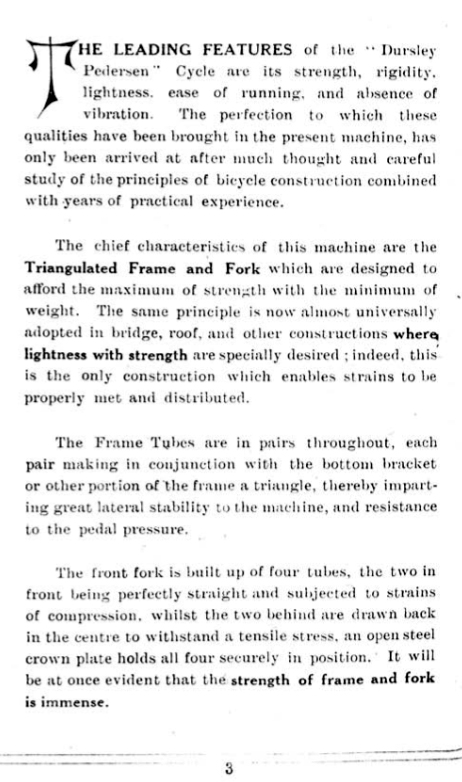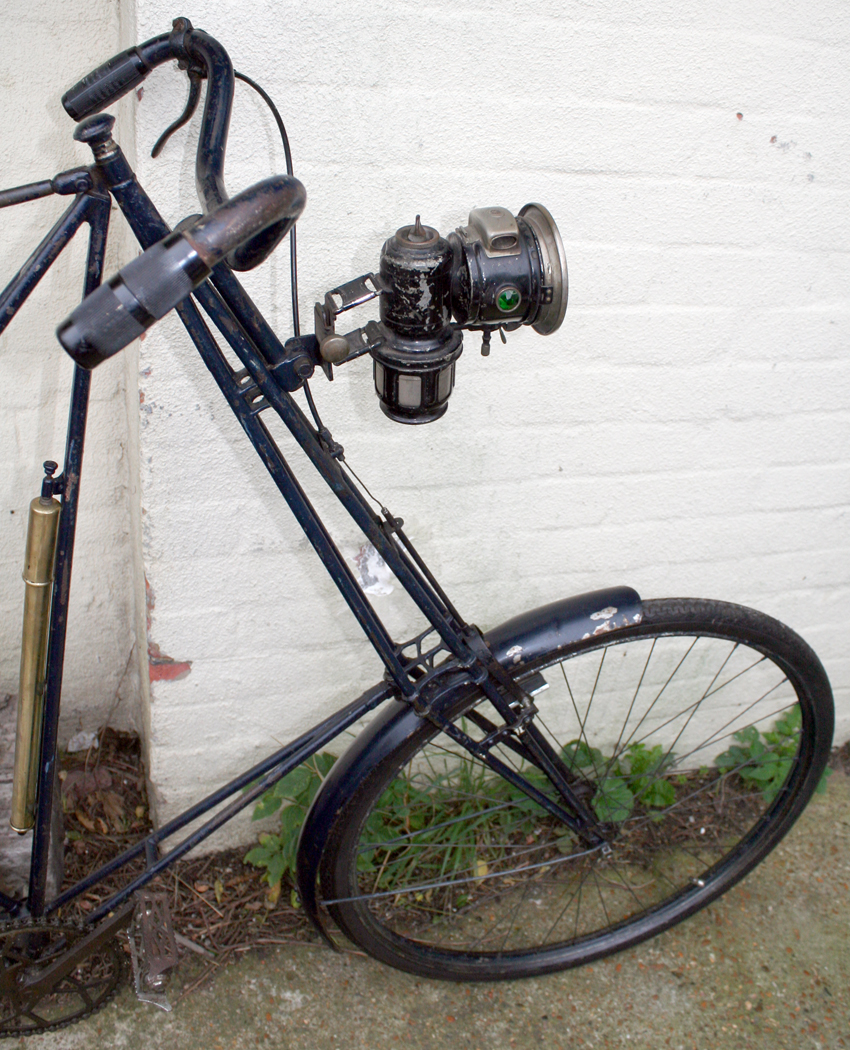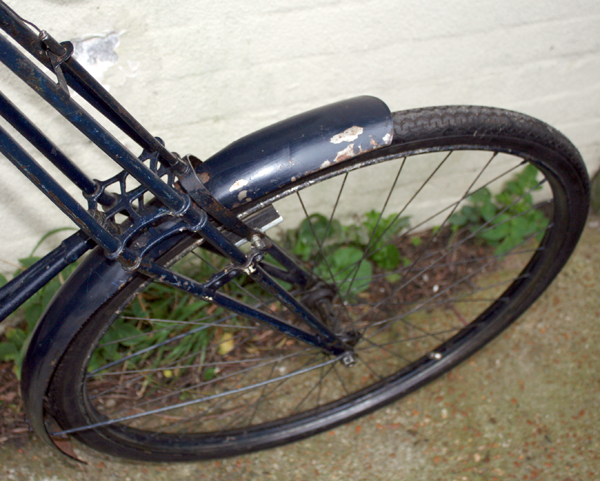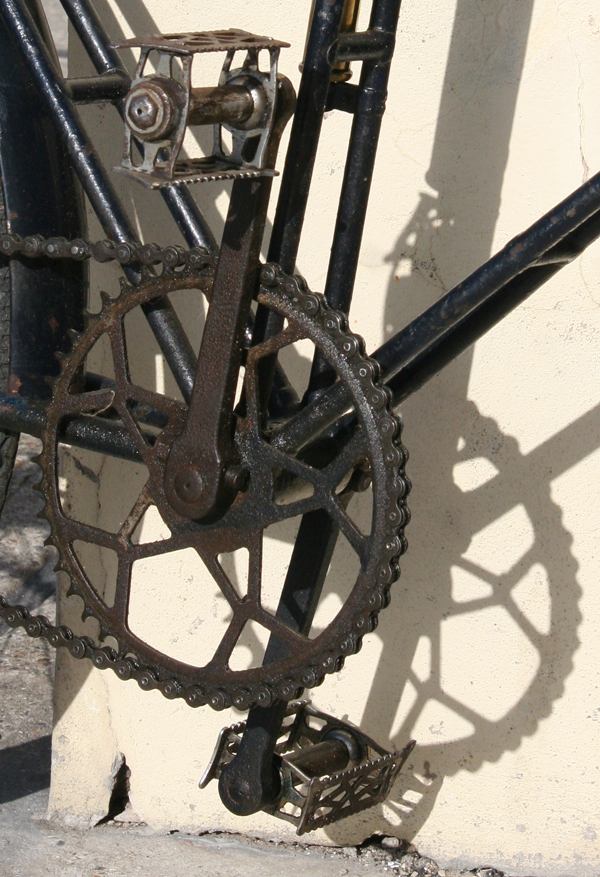1914 Dursley Pedersen Cantilever Gents
1914 Dursley Pedersen Cantilever Gents
Single Speed Coaster (back-pedal) Brake
Frame No 7101 (Club-Registered)
No synopsis of cycling would be complete without Dursley-Pedersen. Its radical design was unfortunately expensive to produce, so it was never accepted into mainstream cycling. Riding the ‘D-P’ therefore became the preserve of the rich. It was a very well made machine and is, these days, very collectible.
One thing that never fails to amaze me when I jump on a D-P is how easy – and comfortable – it is to ride. After lifting your leg over, sitting on the saddle and pedalling off, it takes just a few seconds for the saddle mechanism to adjust to your weight. Then, suddenly, you sink into the saddle …and find yourself coasting and marvelling at the ride.
Though it’s an incredibly lightweight machine, it is nevertheless very stable and responsive to ride.
Once you’ve ridden one you realize why enthusiasts are so crazy about them. It’s a fantastic machine! If Mikael Pedersen had been anywhere near as good at business as he was at designing and inventing, there would have undoubtedly been two dominant styles of bicycles in twentieth century history rather than just one.
Mikael Pedersen gave up making the machines in Dursley in 1914, so this is one of the last of the original D-P’s.
1910 DURSLEY-PEDERSEN CATALOGUE
The DURSLEY-PEDERSEN CYCLE Co
London Office & Showrooms:
188 Gray’s Inn Rd, London W.C
The 1880s and 1890s saw the unstable ordinary or ‘penny farthing’ giving way to the chain-driven smaller wheeled safety bicycle. Mikael Pedersen – a Danish inventor who by 1893 was living in Dursley, Gloucestershire – took out a patent in the same year for a very different design of bicycle weighing only nineteen pounds.
Pedersen had been a cyclist for twenty years and had found seats very unsatisfactory. He therefore developed a hammock type saddle and tried fitting this to current frames before devising his own frame to carry the saddle. The first machine had hickory wood stays, and it is said that these were bound to the joints with fisherman’s twine. All later models used metal tubing, sometimes of remarkable lightness.
Pedersen did his best from 1893 to 1899 to interest cycle manufacturers in his machine, but with limited success. Critics said it lacked lateral strength, its fixed handlebar and saddle heights were inconvenient and its price was too high. However, others praised its strength, lightness, robustness and comfort.
Production of machines in Dursley began in 1897, while other companies made them under licence. In 1899 he joined forces with Robert and Charles Lister to create the Dursley Pedersen Cycle Company. Sales never reached predicted levels as prices were always high compared to other makes – in 1903 when a B.S.A. gents bicycle could be bought for £3, the cheapest Pedersen was £17-17-0. Most machines were therefore bought by the well-to-do.
Pedersen invented a 3-speed hub gear in 1902 and this was put on production models in 1903. Pedersen modified the friction clutch for over a year before he turned to toothed drive. The long delay led to voluntary liquidation in 1905 and a take-over by R.A. Lister and Co. Pedersen then had little to do with the machine but draw royalties. The manufacture of Pedersen cycles ceased in Dursley in 1914 although they were still sold, and perhaps made, in London until 1922.
DURSLEY-PEDERSEN SADDLE
The saddle design is one of the major design features on a D-P, and I believe that improving the comfort of bicycle saddles is what inspired Mikael Pedersen to create the Dursley-Pedersen in the first place.
Fixing a conventional saddle to the D-P – as on this machine – was a common practice once the original hammock wore out.
I have a spare original hammock saddle. You can get a better idea of its design by viewing it like this, off the bicycle.
The saddle below is on a 1909 Ladies Dursley-Pedersen. It’s a variation of the usual style. The leather cover is a very rare accessory.
The coaster hub is a Perry.
DURSLEY-PEDERSEN FOLDING MILITARY BICYCLE
Michael Pedersen designed a folding military model of his famous bicycle for the British Army, in 1900. It had 24 inch wheels, and a low frame so a Soldier could put both feet on the ground while sitting on the saddle. It also had a rifle rack, folding forks, a hammock saddle, and weighed only 15 pounds, and could be carried on the back, and was used in the Boer War effectively.
For the sake of lightness and portability the experimental machine was built with a low frame and 24 ins. wheels, the seat being fixed farther back than usual. By a very simple device the frame can be disconnected (from the front fork) at the head in a few seconds for the purpose of carriage.
Instead of attaching the rifle rigidly to the machine as is customary, it is carried in a vertical position in front on two light projecting arms which work against a spring, so that it is a live instead of a dead weight. It can be detached in a moment and fired without dismounting, the lowness of the seat enabling the rider both feet on the ground. When the bicycle has to be carried it is disconnected and the front wheel, with forks and handlebar secured by the side of the other by a single strap. It can be carried on the bag of a soldier.
The Ingenious Mr. Pedersen by Allan Sutton
Dursley-Pedersen history with thanks to http://www.livinggloucester.co.uk
Illustrations and catalogues with thanks to Veteran Cycle Club
Mads Rasmussen’s Dursley-Pedersen website is definitely worth a visit –
http://www.dursley-pedersen.net/index.html












































